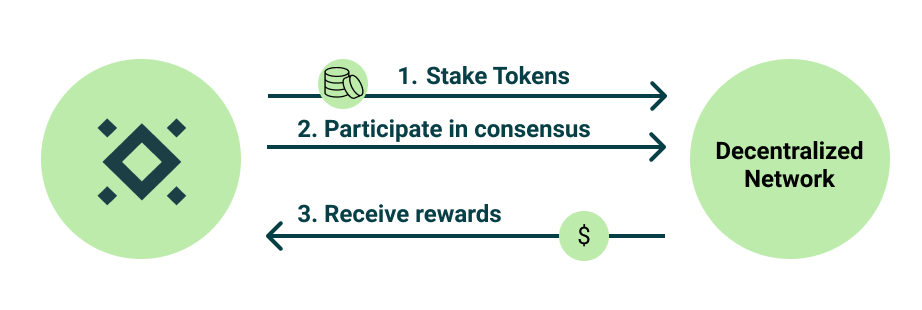Proof-Of-Stake Consensus Algorithm and Staking
Since cryptocurrencies were created as an alternative to the traditional financial system and are decentralised without the intervention of central authorities, blockchain networks use so-called consensus algorithms to verify transactions and add new blocks.

At its most basic level, the consensus algorithm can be understood as a set of rules that govern the network participants and keep the network secure. For blockchain networks, reaching consensus means that at least 51% of the nodes in the network agree on the next global state of the network.
Although many alternative approaches to consensus algorithms have emerged over the years, in practice, two basic algorithms are used most frequently in blockchain networks – Proof-of-Work (PoW) and Proof-of-Stake (PoS).
The Proof-of-Stake consensus algorithm is one of the two most popular methods for reaching consensus on the current state of the network. It is also the most commonly used alternative to Proof-of-Work, which works on a significantly different principle and eliminates the need for miners in the network.
PoS is perceived as a greener and significantly more energy-efficient variant than PoW because, in the case of PoS, miners are replaced by so-called validators who do not need expensive and energy-intensive computing devices to validate transactions and blocks in the network. With growing public criticism of mining and its negative environmental impact, PoS as a green alternative is gaining more and more attention and affection from the general public.
How does it work?
The Proof-of-Stake model allows owners of cryptocurrencies operating on the PoS algorithm to stake their coins and create their own validation nodes. Staking is a process where a user contributes their coins to the protocol in exchange for the opportunity to participate in the validation of blocks in the network. The verification of transactions and the production of new blocks are associated with a block reward consisting of transaction fees and newly issued coins, which the validator collects in case the next block is included in the blockchain. The user directly guarantees the correctness and uniqueness of the transactions with the coins inserted into the protocol.
In the case of block verification on PoS, validators are selected by the protocol itself. However, with most blockchain networks, the algorithm selects validators from a pool of nodes in a random manner based on a combination of various factors, such as the amount of staked coins or the duration of staking.
When a block consisting of transactions is ready to be verified and included in the blockchain, the PoS protocol selects a validator node to review the block. The validator checks that the transactions in the block are correct and that no coins were spent more than once. If everything is in order, the validator adds the block to the blockchain and is rewarded for his work in the form of a block reward. However, if the validator proposes to add a block with inaccurate or fraudulent information, he will lose part or even all of his deposit as a punishment for his dishonest actions.
Staking
The amount of stake required for a user to become a validator varies across blockchain platforms. For example, if someone wants to become a validatfumbor in the new Ethereum network, they must have up to 32 ETH. In the case of the Avalanche network, it is even up to 2000 AVAX. However, it is also possible to stake other PoS coins, such as Cardano, Solana, Cosmos or Polkadot. However, the staking conditions are different for each of these networks.
Therefore, most, especially smaller users, prefer participating in staking pools over running their own validator node. Users can simply delegate a lower amount of coins to a staking pool. The pool owner runs a validation node, into which a larger group of people pool their coins to collectively increase the chance of creating new blocks.
Rewards for the creation of new blocks are then proportionally distributed among the participants of the pool, while the owner of the pool usually charges a small fee for the operation of the validation node. However, pool staking eliminates barriers to entry for small investors and allows them to participate in validating the network and collect rewards for doing so without having to run their own validation node.

However, staking is often associated with a “vesting period”, i.e., when cryptocurrencies are blocked, it is not possible to send them or perform any other activities with them. Therefore, before staking, it is important to review the specific requirements and staking rules for each project you plan to invest your funds in.
Advantages of staking
Many long-term holders of cryptocurrencies see staking as a huge opportunity to let their assets work quietly and collect rewards even during market downturns, in some cases up to 5-10% per year.
Additionally, by participating in staking, the user contributes to the security and efficiency of blockchain projects. The user thus directly strengthens the network whose tokens he owns and makes it more resistant to attacks.
START INVESTING
 3 min •
3 min •



